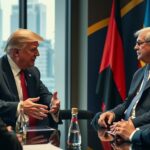Trump’s Tariff Threat: A Stance Against BRICS Nations’ Currency Ambitions
President-elect Donald Trump has threatened a 100% tariff on BRICS nations if they pursue a currency alternative to the U.S. dollar. This threat follows his recent tariff proposals for Canada, Mexico, and China. The BRICS coalition aims to reduce dependency on the dollar, but creating a competitive currency remains a complex challenge. Economists warn about potential negative impacts on U.S. consumers and the implications this stance could have for global economic relations.
President-elect Donald Trump recently issued a bold warning on Nov. 30, indicating potential imposition of a 100% tariff on nine nations collectively known as the BRICS, consisting of Brazil, Russia, India, China, South Africa, Egypt, Ethiopia, Iran, and the United Arab Emirates. The threat is contingent upon these nations’ attempts to establish a competing currency or promote alternatives to the U.S. dollar as the global reserve currency. “We require a commitment from these Countries that they will neither create a new BRICS Currency, nor back any other Currency to replace the mighty U.S. Dollar or, they will face 100% Tariffs,” Trump stated on Truth Social. This stance aligns with recent tariff discussions related to Canada, Mexico, and China, aimed at compelling these nations to enhance their efforts against illegal immigration and drug trafficking into the U.S.
The BRICS nations, formed in 2009, aim to bolster the interests of emerging economies and lessen dependency on the U.S. dollar, which dominates global trade and finance. The dollar’s global status affords the U.S. substantial economic advantages, such as lower borrowing costs and enhanced geopolitical power. Recent discussions at BRICS summits have included proposals for alternative currencies, prompted by sentiments that the dollar is wielded strategically. Notable calls for new currencies have been made by leaders such as Russian President Vladimir Putin and Brazilian President Luiz Inácio Lula da Silva. However, the feasibility of establishing a BRICS currency remains highly contested due to the formidable global position of the dollar and the complexities of unifying the BRICS member economies.
In conclusion, Trump’s threats against the BRICS nations regarding potential tariffs serve as a significant illustration of the geopolitical tensions surrounding currency dominance. While the likelihood of these tariffs materializing appears slim, they reflect anxieties about the dollar’s position as the primary reserve currency. The responses from economists highlight concerns regarding potential inflationary consequences for American consumers and broader implications for U.S. global economic standing. The situation necessitates ongoing scrutiny as international dynamics evolve.
Original Source: www.cbsnews.com








Post Comment